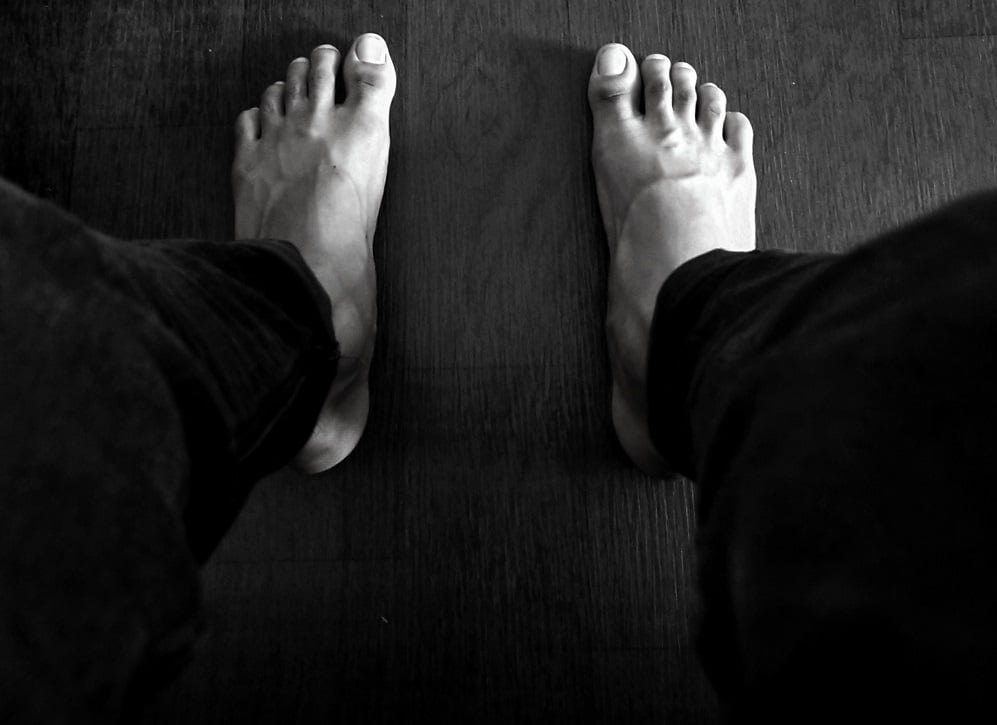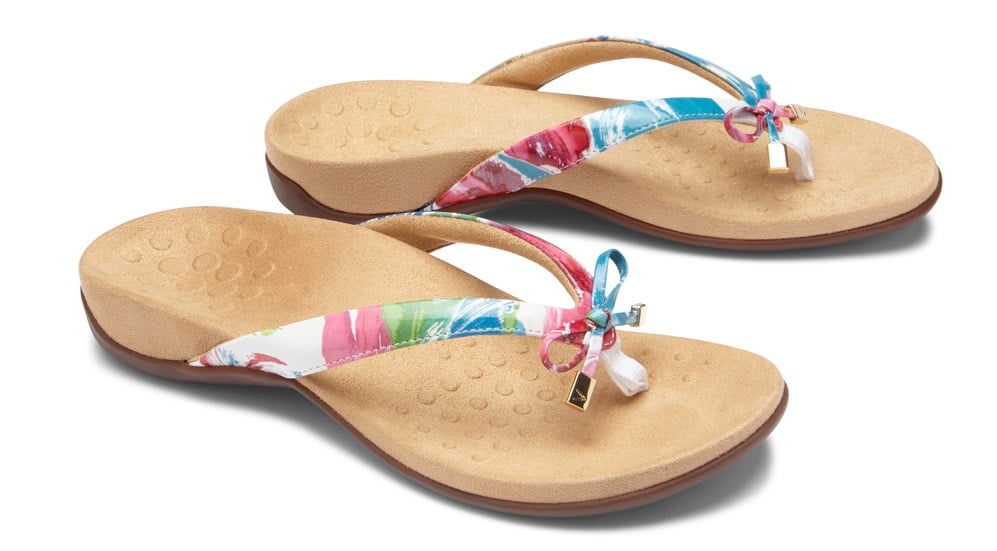
There are over 100 types of arthritis, and in the United States, a staggering 23% of the adult population suffers from some form of the condition.¹ Characterized by joint inflammation, arthritis typically causes pain, swelling, tenderness, and stiffness.
Certain forms of arthritis are more likely to affect the lower extremities. If you think you or a loved one might have the condition, you should be aware of the most common arthritis symptoms in the feet, toes, and ankles. If you do have arthritis, it is so important to find a pair of comfortable sandals that are supportive. Vionic is here to walk you through the various signs and sensations of arthritis. Let’s get started.
Types of Arthritis in Feet
With upwards of 30 joints in each of your feet and ankles, there are many opportunities for inflammation to wreak havoc. While arthritis comes in many forms, the types that most often affect the feet include osteoarthritis, rheumatoid arthritis, gout, and post-traumatic arthritis.² Find a breakdown of each condition and the various symptoms below. It’s important to know the symptoms because you could have a different foot condition such as gout. Learn how to prevent gout and what gout feels like, to see if that might be the cause of your pain.
Osteoarthritis Symptoms
Osteoarthritis is the most common type of arthritis.³ Sometimes called “wear and tear” arthritis, it typically occurs in adults 50 and older, when their joint cartilage wears down with age.
Symptoms of osteoarthritis in the feet can include:
- Pain
- Tenderness
- Swelling
- Stiffness
- Loss of flexibility
- A popping noise in the joint
- Bone spurs
Some people with osteoarthritis also notice a grating sensation when they move their joints. This is likely a result of the bones rubbing against each other without cartilage to cushion them.
Rheumatoid Arthritis Symptoms
Rheumatoid arthritis is an autoimmune disease characterized by chronic inflammation in multiple joints throughout the body.⁴ It occurs when a person’s immune system attacks the bone tissue lining their joints.
Symptoms of rheumatoid arthritis can include:
- Pain and tenderness
- Warmth around the joints
- Swelling
- Stiffness
- Fatigue
- Fever
- Appetite loss
Though most types of arthritis often only affect one side of the body, rheumatoid arthritis tends to be more symmetrical, meaning both feet can become inflamed.
Gout
Gout is a common type of arthritis and also one of the most painful. The inflammatory condition is caused by a buildup of uric acid in the bloodstream and usually affects joints in the lower extremities, particularly the big toe.⁵
Symptoms of gout can include:
- Sudden and severe pain
- Tenderness
- Swelling
- Redness
- Throbbing
- A burning sensation
- A lump at the joint
- Lingering joint discomfort
- Reduced range of motion
These symptoms occur when someone is experiencing what’s called a gout attack. Foot pain and other symptoms usually peak 12 to 24 hours after they start and then slowly subside over the next couple of weeks.
Post-Traumatic Arthritis Symptoms
Post-traumatic arthritis happens when a previously injured joint wears down.⁶ For instance, cartilage damage from a fractured toe or sprained ankle that occurred years ago could cause the joint to deteriorate earlier than usual.
Symptoms of post-traumatic arthritis can include:
- Pain and tenderness
- Ongoing discomfort
- Swelling
- Fluid in the joint
- Reduced flexibility
Those with post-traumatic arthritis may also experience mobility issues, as walking, climbing stairs, and standing can put stress on the affected joint.
What Foot Areas Does Arthritis Affect?
Arthritis usually affects the joints involved with stability and balance. The condition often crops up in the big toe, midfoot, heel, and ankle. Here’s what you should know.
Symptoms of Arthritis in the Big Toe
Big toe arthritis is common. Also known as hallux rigidus, the condition occurs when the joint connecting the base of the toe to the rest of the foot becomes inflamed.⁷
Symptoms of hallux rigidus can include:
- Pain
- Stiffness in the joint
- Swelling
- A bump at the base of the big toe
- Decreased range of motion
Pain is typically the most noticeable symptom and also the most debilitating. Those suffering from big toe arthritis may experience pain when they walk or bear any body weight, which can lead to mobility issues.
Symptoms of Osteoarthritis in the Midfoot
Osteoarthritis can occur in the foot arch when the joints connecting the front of the foot to the ankle become inflamed. Sometimes called midfoot arthritis, it can be a result of a previous injury or develop with age due to wear and tear.
Symptoms of midfoot arthritis can include:
- Discomfort in the foot arch
- Pain while walking or standing
- Loss of flexibility
- A flattened arch
Experiencing arthritis pain while walking can understandably make a person resist all physical activity. However, avoiding movement may lead to increased stiffness and worsened mobility issues.
Symptoms of Arthritis in the Heel
Heel pain can occur for many reasons, including plantar fasciitis, injury, infection, or autoimmune issues. It can also be a result of inflammatory arthritis, including rheumatoid arthritis, osteoarthritis, and psoriatic arthritis.
Symptoms of arthritis in the heel can include:
- Heel pain
- Tenderness
- Swollen feet and ankles
- Muscle spasms
As with all types of arthritis in the feet, when the joints connecting the heel bone become inflamed, it can be incredibly painful to walk, potentially leading to long-term mobility issues.
Symptoms of Arthritis in the Ankle
If you’re experiencing ankle pain, it could be a sign of osteoarthritis, rheumatoid arthritis, or gout. Ankle arthritis occurs when the joints connecting the ankle bone to the shin bone become inflamed.
Symptoms of arthritis in the ankle can include:
- Pain and tenderness
- Swelling
- Instability
- A lump at the joint
- Limited range of motion
The pain and discomfort can make it immensely difficult to walk or stand for long periods. This type of arthritis can also lead to a foot deformity.

How to Improve Arthritis Symptoms
Arthritis in the feet can be not only uncomfortable but also debilitating. The good news is that there are many treatments available for improving symptoms and flare-ups, including some at-home remedies.
Here’s what might help:
- Over-the-counter NSAIDs (non-steroidal anti-inflammatory drugs)
- Maintaining a healthy body weight
- Implementing a walking routine
- Walking with a cane to minimize stress on the joint
- Wearing supportive shoes or inserts
Is walking good for arthritis in the feet? Though it may seem counterintuitive to exercise when physical activity is painful, walking can actually be very beneficial in managing arthritis in the feet—especially when you wear proper footwear.

The Best Shoes for Arthritis in the Feet
If you have osteoarthritis, rheumatoid arthritis, post-traumatic arthritis, or gout in your feet, we encourage you to consider orthotic shoes. Vionic is proud to offer a substantial selection of men’s and women’s supportive footwear.
Each pair has built-in arch support, deep heel cups, contoured footbeds, and durable outsoles to reduce joint pain and promote a healthy stride. We carry a wide range of styles, including comfortable sandals, slides, walking shoes, flats, active shoes, sneakers, slippers, and more.
Order a pair of orthotic shoes today!
External sources:
- “Arthritis-Related Statistics”. CDC. https://www.cdc.gov/arthritis/data_statistics/arthritis-related-stats.htm
- “Foot and Ankle Arthritis”. Clevelan Clinic. https://my.clevelandclinic.org/health/diseases/13900-foot-and-ankle-arthritis
- “Osteoarthritis”. Mayo Clinic. https://www.mayoclinic.org/diseases-conditions/osteoarthritis/symptoms-causes/syc-20351925
- “Rheumatoid arthritis”. Mayo Clinic. https://www.mayoclinic.org/diseases-conditions/rheumatoid-arthritis/symptoms-causes/syc-20353648
- “Gout”. Mayo Clinic. https://www.mayoclinic.org/diseases-conditions/gout/symptoms-causes/syc-20372897
- “Post-Traumatic Arthritis”. Cleveland Clinic. https://my.clevelandclinic.org/health/diseases/14616-post-traumatic-arthritis
- “Hallux Rigidus”. Cleveland Clinic. https://my.clevelandclinic.org/health/diseases/14665-hallux-rigidus
- Patel, Amar et al. “Midfoot arthritis.” The Journal of the American Academy of Orthopaedic Surgeons vol. 18,7 (2010): 417-25. doi:10.5435/00124635-201007000-00004
- “Joint Pain and Arthritis”. CDC. https://www.cdc.gov/arthritis/pain/index.htm


Leave a Reply